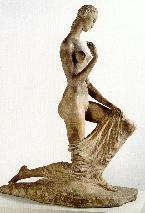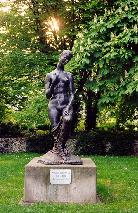Lehmbruck, Wilhelm |
| SCULPTOR, MEDALIST, GRAPHIC ARTIST (GERMANY) |
|
BORN 4 Jan 1881, Duisburg, Nordrhein-Westfalen: Meiderich - DIED 25 Mar 1919, Berlin BIRTH NAME Lehmbruck, Heinrich Wilhelm CAUSE OF DEATH suicide by gassing GRAVE LOCATION Duisburg, Nordrhein-Westfalen: Waldfriedhof, Düsseldorfer Strasse (Feld 47, Nr 1-2) |
|
Wilhelm Lehmbruck came from a mining family. He worked at studios in Düsseldorf to pay for his education at the Kunstgewerbeschule in that city. In 1904 he travelled to the Netherlands, Belgium and England and after selling some of his works he was able to visit Italy in 1905. In 1906 his work was shown at several local exhibitions and in 1907 he set up his own studio. In 1908 he married Anita Kaufmann and in 1909 their son Manfred Wilhelm was born. Lehmbruck now frequently exhibited in Paris and supported by the collector Carl Nolden he went to live there in 1910. His work became more and more successful and in 1912 the Museumsverein Duisburg ordered a marble version of his "Grossen Stehenden". Related to this commission he travelled to Italy for the second time. More invitations to participate in exhibitions soon followed, from Berlin, Cologne and other cities. In 1913 a second son, Manfred, was born. Because of the war he returned to Duisburg-Meiderich in 1914 and in November he went to Berlin, where he had participated in the first exhibition of the Freie Secession earlier that year. The collector Sally Falk visited Lehmbruck in 1916 and soon bought several of his works with the help of art dealer Paul Cassirer. Later in 1916 Lehmbruck portrayed Falk and his wife in Mannheim, where his first solo exhibition started in November. From Mannheim he travelled to Switzerland to wait for the end of the war. His third son Guido was born in 1917. In that year he met the writer Fritz von Unruh, who soon became a close friend. Through Albert Ehrenstein he met the young actress Elisabeth Bergner. He visited of her theatre performances and she sat for him several times. Lehmbruck, who had fallen in love with her, asked her to read poems by Holderlin at those occasions. Elizabeth Bergner did not return his affections, and only later she understood why he called her 'Marja': it was a combination of Mascha (the name of the gipsy girl she represented at her first sitting with Lehmbruck) and Tolstoy's Fedja, who committed suicide. In 1918 Lehmbruck followed her to Berlin, leaving his family in Zürich. However, he must must have been convinced of the hopelessness of his love and the crisis in his life deepened. In 1919 he went to Berlin again. At that time he was a member of the Prussian Academy of Arts (together with mit Ernst Barlach, Käthe Kollwitz and Lovis Corinth). But the official statement was sent to the wrong address on 19 Mar 1919 and it is unclear if Lehmbruck ever knew about it. Haunted by his depressions he committed suicide a few days later on 25 March 1919. He was buried in Berlin. Lehmbruck's wife Anita died in Stuttgart in 1961. In 1962 the remains of Lehmbruck and his wife were moved to the Waldfriedhof in Duisburg. Elisabeth Bergner became a well known actress and after a long career she died in London in 1986. In her memoirs, that were published in 1978, she described Lehmbruck's affections for her. Related persons • used as a model Bergner, Elisabeth • has a connection with Cassirer, Paul • knew Goll, Ivan • knew Goll-Aischmann, Clara • knew Modigliani, Amédéo • met Werefkin, Marianne von |
Sources • Bergner, Elisabeth, Bewundert viel und viel gescholten, Elisabeth Bergners unordentliche Erinnerungen, Bertelsmann, München, 1978 • Hartog, Arie, Veronika Wiegartz & Kai Fischer (ed.), Wilhelm Lehmbruck, Gerhard Marcks-Stiftung, Bremen, 2000 • Wilhelm Lehmbruck - Wikipedia (DE) |









